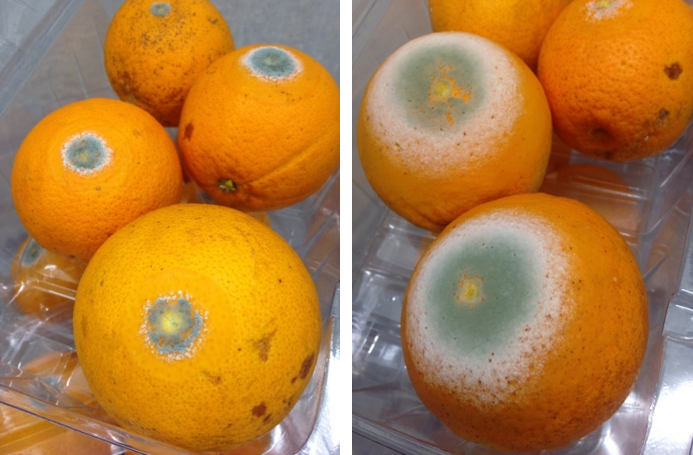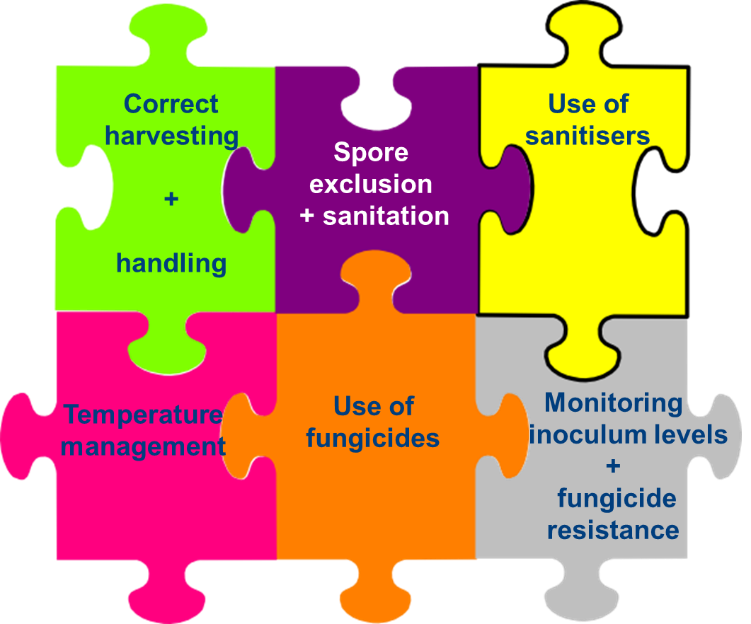
Review your postharvest fungicides
John Golding, NSW Department of Primary Industries, July 2021
Postharvest fungicide use is important to control decay such as green mould, blue mould (Figure 1) and sour rot, which can occur during storage. However, fungicides are just one tool required to effectively manage postharvest decay. Several other management factors such as correct harvest and handling are also needed (Figure 2).

Figure 1. Blue mould and green mould.
While routinely using the same postharvest fungicide program throughout the season is easy, continually using the same fungicide, particularly with poor packinghouse practices and sanitation, can lead to fungicide resistance developing. It is important to use fungicides with different modes of action (MOA) to prevent fungicide resistance. Resistance to postharvest fungicides occurs when the decay fungi grow in the presence of the fungicide, therefore making the fungicide ineffective.

Figure 2. Postharvest fungicides are just one component of decay control.
With the season in full swing, there is no better time to re-examine your postharvest fungicide program. Table 1 lists the postharvest fungicides that are currently registered and available. This table is currently available on the postharvest page of the Citrus Australia website (https://citrusaustralia.com.au/growers-industry/post-harvest) and the NSW DPI citrus website (https://www.dpi.nsw.gov.au/agriculture/horticulture/citrus).
For updates on changes to these postharvest fungicides, please check the APVMA Public Chemical Registration Information System Search (PubCRIS) database at https://portal.apvma.gov.au/pubcris. This APVMA website is an excellent resource to find the most up to date details including product name, registering company, active constituents and product category for not only registered postharvest chemicals, but all agricultural chemicals.
Table 1. Summary of current postharvest fungicides.
Active ingredient(s) | Trade names1 | What does it control | Fungicide group | FRAC Group number |
Fludioxonil | Fludy® | blue mould, green mould, activity also on Diplodia stem end rot | Phenylpyrrole | Group 12 |
Guazatine2 | Panoctine® | sour rot with activity also on blue and green mould | Multi-site activity (Guanidine) | Group M7 |
Imazalil | Fungaflor®Magnate® | blue mould, green mould | Demethylation Inhibitors (DMI) (Imidazole) | Group 3 |
Imazalil and pyrimethanil | Philabuster® | blue mould, green mould | DMI and anilinopyrimidine | Group 3 and Group 9 |
Propiconazole and fludioxonil | Chairman® | blue mould, green mould, sour rot | DMI and phenylpyrrole | Group 3 and Group 12 |
Pyrimethanil | Penbotec® | blue mould, green mould | Anilinopyrimidine | Group 9 |
Sodium ortho-phenylphenate | Preventol® ON Fungicide | blue mould | ||
Thiabendazole (TBZ) | Vorlon®Tecto® | blue mould and green mould with activity on stem end rot, Phomopsis citri | Benzimidazole | Group 1 |
1 Other trade names exist. Please see the APVMA website for all registered chemicals.
2 Check that this is registered in your state or territory.
Postharvest fungicide selection must not only be based on efficacy and practical use within the packing line, but also depends on where the fruit is going to be sold because in-market maximum residue limit (MRL) requirements have to be met. For fruit to be sold on the domestic market, all postharvest fungicides are allowed and should meet MRL requirements when used according to the label. For export markets, some postharvest fungicides such as guazatine are not allowed in some markets.
For an up to date summary of the export MRLs, please consult with the Citrus Australia MRL listings (https://citrusaustralia.com.au/growers-industry/export-mrl-listing).
These are regularly updated to ensure the industry has the most up to date information to make informed decisions.
Acknowledgements
This is article is a contribution from the Citrus Postharvest Program (CT19003) funded by Horticulture Innovation and NSW Department of Primary Industries. Levies from Australian citrus growers are managed by Horticulture Innovation and contributed to funding this project. The Australian Government provides matched funding for all Horticulture Innovation’s research and development activities.

